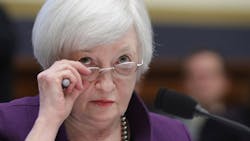Fed Minutes Confirm December Hike Expectations
WASHINGTON—Minutes of the Federal Reserve's late October policy board meeting confirmed Wednesday that participants expected to begin raising interest rates in December.
While some at the October 27-28 meeting of the Federal Open Market Committee said it was already time for the first rate increase in over nine years, "most participants" expected the economic conditions would be right by their December 15-16 meeting, the minutes said.
That confirmed the central message of the formal October FOMC statement, a surprisingly specific reference to the possibility of a rate increase next month, contingent on key economic data showing continuing improvement.
The minutes of the FOMC meeting showed that the group had largely dropped their concerns about slower global growth and market volatility as the first increase in the benchmark federal funds rate in more than nine years approaches.
Taking that step -- which would begin a slow series of rate increases towards policy "normalization" -- would put the Fed on the opposite path of its counterparts in Japan and Europe, where central banks lean toward easing policy.
The federal funds rate, which influences the cost of borrowing in dollars around the world, has sat at 0-0.25% since December 2008, locked at an extraordinary low to support the economy's slow recovery from the Great Recession.
With what is essentially very cheap money pumped into the economy for so long, some analysts fear Fed policy has laid the seeds for new stock or property bubbles and a burst of damaging inflation.
But while asset markets are somewhat inflated, inflation pressures remain absent, allowing the Fed to continue providing stimulus.
Even so, Fed Chair Janet Yellen has said repeatedly this year that she expects rates to rise by the end of 2015.
Global markets have moved in response, tightening borrowing costs for emerging market governments and companies and pushing the dollar higher against their currencies.
A December increase is still not a certainty. The Yellen-led FOMC always makes its view contingent on what the newest official data says about the strength of the economy going forward.
Since the last FOMC meeting, the data has been generally positive, with a strong October employment report showing the unemployment rate fell to 5.0%, the lowest level since early 2008.
But inflation remains much weaker than the Fed wants to see, and signs of consumer spending strength going into the year-end holiday season have been mixed.
Cautious 'Doves'
Indeed, a few -- apparently a small minority -- of the Fed officials participating in the meeting showed concern that the economy was still vulnerable to a more severe global slowdown and the impact of a "premature" tightening of monetary policy.
They suggested that the FOMC be prepared, on the contrary, to consider options for loosening monetary policy if the US economic picture weakened.
Ian Shepherdson of Pantheon Macroeconomics interpreted the record of the meeting as raising the likelihood of a December rate increase.
However, he noted, "Plenty of cautious commentary from the doves is littered through the minutes."
Besides their confidence in the data, a number of Fed policymakers were concerned that, having built up expectations of a hike for so long, not moving would send markets a disturbing message and also erode FOMC credibility.
Delaying an increase "could increase uncertainty in financial markets and unduly magnify the perceived importance of the beginning of the policy normalization process," the minutes said.
Markets, already having bought into the idea of a December move, were unmoved by the FOMC minutes Wednesday. Wall Street stocks continued a day-long climb, with the S&P 500 up 1.4% in late trade, while the dollar was little-changed at $1.0647 per euro.
Copyright Agence France-Presse, 2015
About the Author
Agence France-Presse
Copyright Agence France-Presse, 2002-2025. AFP text, photos, graphics and logos shall not be reproduced, published, broadcast, rewritten for broadcast or publication or redistributed directly or indirectly in any medium. AFP shall not be held liable for any delays, inaccuracies, errors or omissions in any AFP content, or for any actions taken in consequence.
